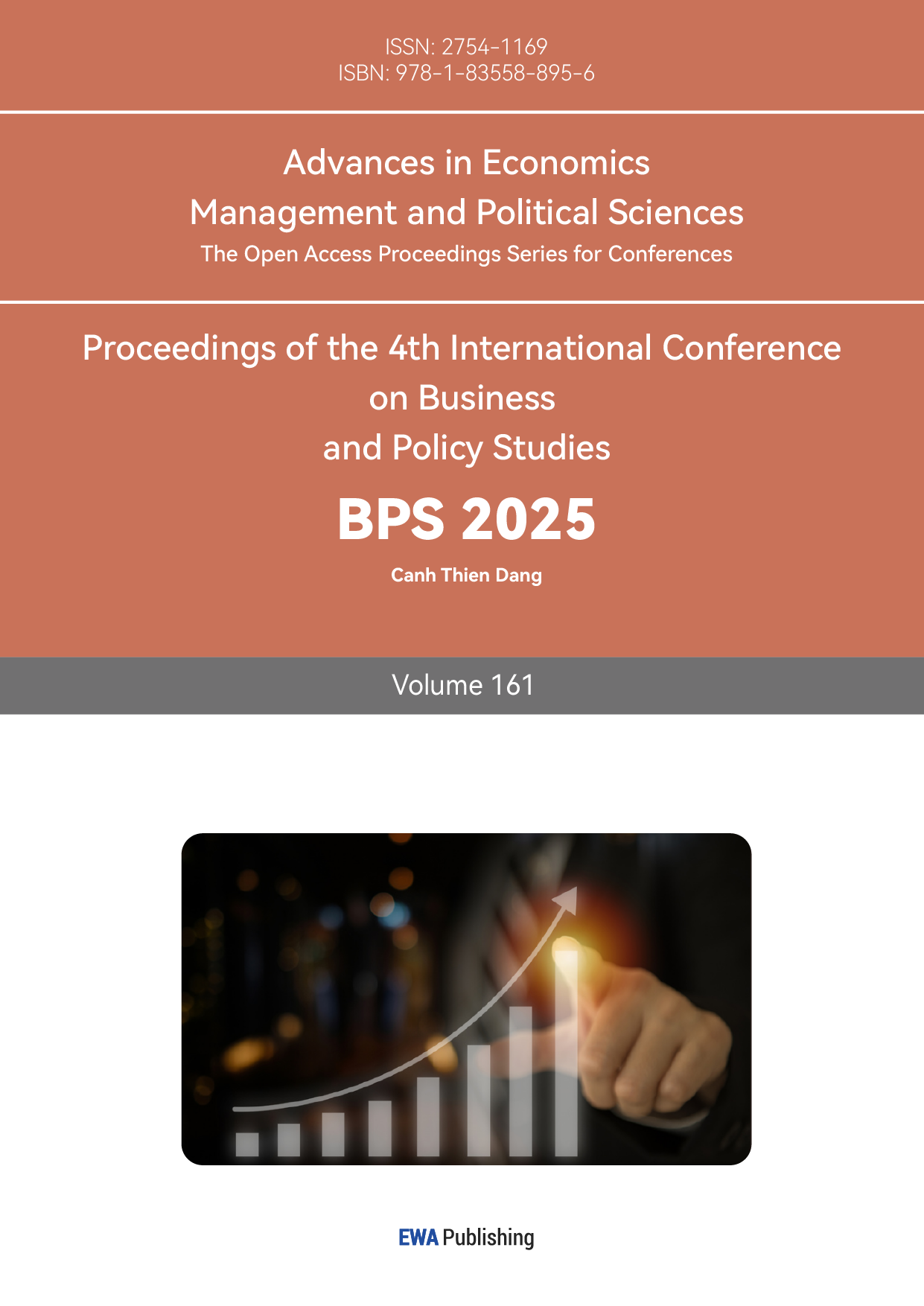1. Introduction
Since the outbreak of COVID-19 in late 2019, it has spread rapidly all around the world, not only posing a crisis to the global public health system, but also having a huge impact on the global economy. Gradually, countries have adopted varying degrees of lockdown measures to prevent the virus from spreading further and endangering the health of more residents. [1]This has undoubtedly had a huge impact on consumer behavior.
The COVID-19 pandemic has brought a lot of changes in consumer behaviors, such as the shift from offline to online consumption [2], the increase in the purchase of daily necessities and the decrease in the purchase of luxury goods. At the same time, the mode of consumption has shifted from face-to-face to contactless. These changes have affected the consumption patterns from a microscopic perspective and had a huge impact on the global economy.
In this context, it is particularly important to study the impact of COVID-19 on consumer behavior. On the one hand, the epidemic has altered numerous factors that influence consumer consumption behavior, resulting in a significant shift from previous patterns.On the other hand, the epidemic has promoted the rapid development of the digital economy[3]. The most typical example is the rise of new consumption patterns such as online courses, working from home or online shopping. These changes are new perspectives for the study of consumption behavior.
In addition, China and United States are the two largest economies in the world. Their consumption behaviors have also been greatly impacted by the epidemic. Therefore, studying the changes in consumption behaviors in China and United States after COVID-19 is also crucial to the recovery of the global market and world economy in the post-epidemic era.
Therefore, this paper through the comprehensive analysis of domestic and foreign literature explores the impact of COVID-19 on consumer behavior, and analyzes the underlying reasons behind the such a status quo and future development trends to make a forecast. Finally, it provides the corresponding countermeasures for the micro-economy with the analysis content. Furthermore, this paper will discuss the potential long-term effects of COVID-19 on consumer behavior and the economy. It will also provide recommendations for businesses and policymakers to adapt to the new normal and stimulate economic recovery.
In conclusion, this paper aims to provide a comprehensive understanding of the impact of COVID-19 on consumer behavior and the economy. By analyzing the changes in consumer behavior in China and the United States, it aims to offer valuable insights and recommendations for the post-epidemic era.
2. Comparative Analysis of Changes in Consumption Behavior between China and the United States
2.1. Changes in consumption methods
During the epidemic, consumption patterns in China and U.S. have undergone tremendous changes, among which the rise and surge in online consumption is the most obvious and prominent feature.
First, the rapid growth of online consumption is a common feature between China and the United States. It will be needed to recognize that this trend was already on display before the epidemic, but the epidemic also undoubtedly accelerated its formation and development. In the United States, e-commerce platforms such as Amazon, Walmart and Target have become the main channels for consumers to purchase goods. Whether it is necessities such as food, daily necessities and medical supplies, or non-essentials such as clothing, electronic products, and household items, a large number of sales have been achieved through e-commerce platforms, driving the growth of online consumption.[4] In China, epidemic has also caused a large number of consumers to turn to online consumption. Sales of e-commerce platforms such as Alibaba and JD.com increased significantly during the epidemic, especially in areas such as fresh food, health products and online education services.[5]
Besides, there are different driving factors behind the growth of online consumption in China and the United States. For the United States, the growth of online consumption is mainly due to the mature and complete e-commerce market and the extremely popular Internet technology. In other words, many American consumers are already accustomed to online consumption. Therefore, when the epidemic broke out, they were able to quickly adapt to their backup consumption channel—online consumption. In contrast, for China, the growth of online consumption is mainly due to the rapid development of e-commerce platforms and convenient mobile payments, such as Wechat pay and Alipay. Mobile pay makes online consumption more convenient. At the same time, Chinese e-commerce platforms such as Alibaba and JD.com launched various promotional activities and preferential policies during the epidemic, further promoting the growth of online consumption.
In addition, the characteristics of online consumption in China and the United States are somewhat different. In the United States, the growth of online consumption is mainly concentrated in some traditional large e-commerce platforms, such as Amazon, Walmart and Target. These platforms have strong supply chains and transportation chains, which can ensure their product supply during the epidemic. They also have a wide variety of products. These can meet the personalized needs of consumers and have a strong and lasting appeal to them. In China, the growth of online consumption is not only reflected in large e-commerce platforms, but also in various emerging social e-commerce platforms and live streaming platforms. Live streaming has emerged as a major highlight of China's e-commerce industry during the epidemic. A large number of Chinese consumers prefer to learn more about products and make purchasing decisions through social media and live streaming platforms. At the same time, many brands and product suppliers seize this opportunity to interact with consumers in detail through live streaming platforms, promote and advertise their products, and even incite consumers to follow the crowd. Therefore, this consumption method of using social media to complete purchases has been very successful during the epidemic, greatly promoting the increase of online consumption.
In summary, the growth of online consumption during the COVID-19 is a significant trend common to both China and the United States. We know that China and the U.S. have their own economic and financial development, but this time the same trend is undoubtedly a reflection of the fact that human beings react in the same way to sudden health emergencies. But the growth patterns and driving factors behind them are different. These differences reflect the differences in consumer habits, technological levels, and consumer market environments between China and the United States. With the gradual control of COVID-19 and the recovery of the world economy, it is likely that the trend of online consumption growth will persist and shape the future consumer market.
2.2. Changes in consumption structures
During the COVID-19, the demand for daily necessities and non-necessities in China and the U.S. has also changed in a very significant way. This section aims to analyze the changes in these two aspects and to explore the socioeconomic factors behind them. In the United States, consumer demand for daily necessities has stabilized, especially for some food and medical supplies. The lack of excessive increases is due to the government's lockdown measures at the beginning of the epidemic, and the lack of excessive declines is due to consumers stockpiling some daily necessities. However, the demand for some non-essential goods, such as luxury goods, has dropped significantly. [6] This is mainly because of the decline in the overall economic environment, the sharp increase in the unemployment rate in the United States, and the high inflation rate caused by COVID-19, which caused the decrease of purchasing power of money. In China, the government’s effective control of the COVID-19 and the rapid recovery of the economy will help maintain stable demand for daily necessities. However, there have been shortages of some products such as masks and disinfectants due to high demand and supply chain disruption. Demand for non-essential goods in China has also fallen, but the decline is smaller compared to the United States. This is attributed to the economic stimulus methods of government and the quick recovery of Chinese economy.
The stability of consumption of daily necessities and the changes in consumption of non-essential goods in China and the United States are mainly due to the following socio-economic factors. Firstly, it is about the consumption concept. COVID-19 highlights the importance of daily necessities. People’s panic caused by the COVID-19 has led them to pay more attention to the most basic living conditions as human beings, such as foods or some kind of medical supplies, which can protect them from infection. At the same time, the epidemic has also changed consumers' preferences, making them pay more attention to health and safety products and reducing their willingness to consume non-essential products. Then, we need to move on the purchasing power of consumers. The long-term economic downturns have forced many enterprises to adopt steps such as layoffs or salary cuts, which has led to a sharp increase in the unemployment rates and a sharp decrease in the consumer purchasing power. Many countries have adopted a series of travel restrictions to varying degrees in order to protect the health of their citizens. Then the residents of each country have to abide by these regulations. The most direct consequence of this is that a large number of transactions are forced to be interrupted. Alternatively, one could choose to voluntarily curtail trade to safeguard the well-being of the workforce. A lot of workers and other laborers are unable to reach their workstations to carry out due to epidemic prevention and control measures. This leads to a large number of enterprises having reduced production, so COVID-19 led business to shut down. For some large enterprises they can use years of profits to cover short-term shortfalls. But for some small enterprises, they will have to face the bankrupt and credit problems. To pursue profits, enterprises have to cut employees’ salaries. In this way, there is a direct shortage or decrease of funds available for consumption in the hands of residents. At the same time, the economic downturns also caused the increase of inflation, leading to the increase of Consumer Price Index. Consumer Price Index (CPI) is an indicator that measures the price changes of consumer goods and services in a country or a region over time. It is a relative number that reflects the trend and degree of changes of the consumer price level and plays an important role in macroeconomic analysis and decision-making. Meanwhile, the inverse of CPI is also considered the purchasing power of money. According to Figure 1 and Figure 2, we can clearly see that CPI in China and the United States has continued to rise after the COVID-19. Due to the inverse relationship between purchasing power of money and CPI, this means purchasing power of money has continued to decline after the COVID-19.
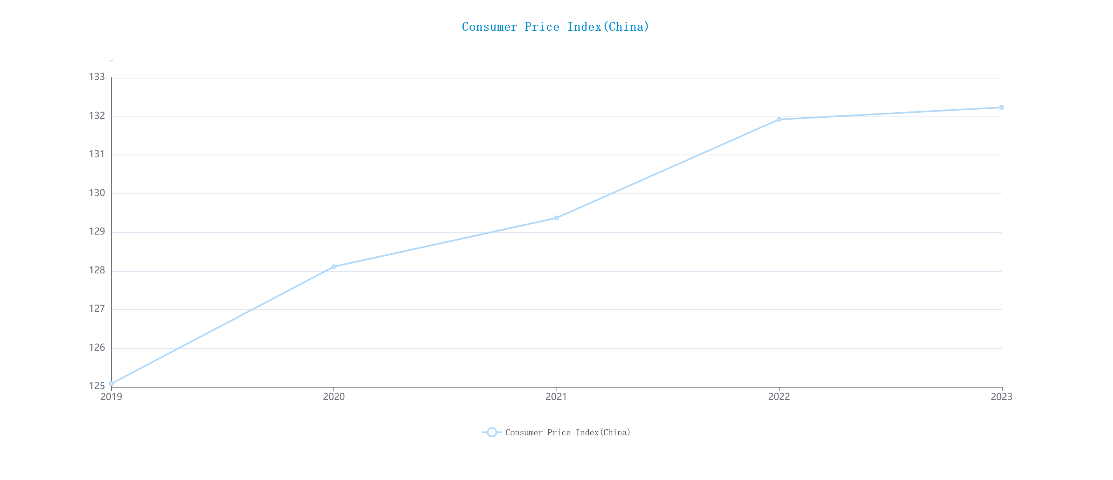
Figure 1: China Consumer Price Index (2019-2023)[7]
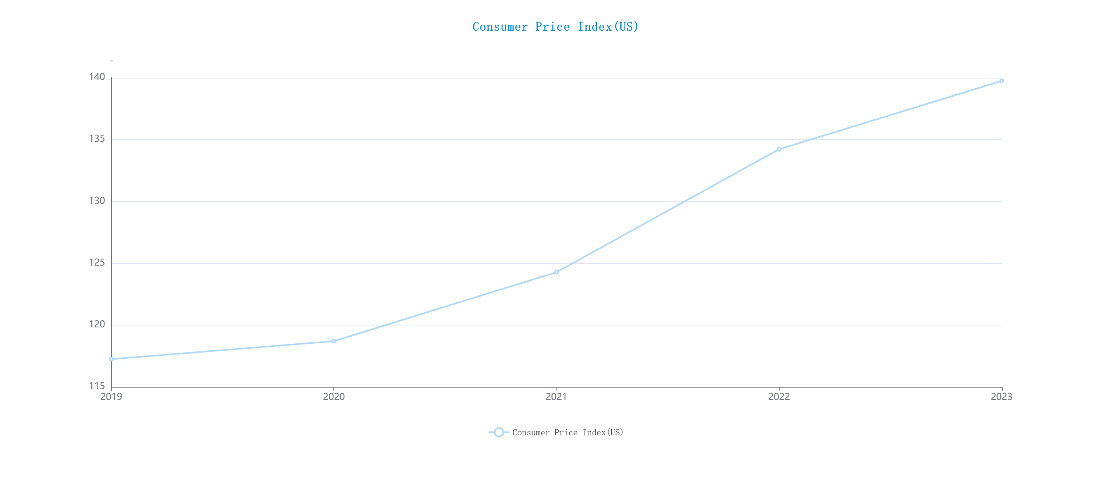
Figure 2: the U.S. Consumer Price Index (2019-2023)[7]
As for the government, they will intervene in the supply chain of certain industries, such as China's efficient mask production. So, the important of government’s intervention can’t be ignored either. In conclusion, the COVID-19 pandemic has had a significant impact on the demand for essential and non-essential goods in both the United States and China. The stability of essential goods demand can be attributed to the government’s intervention in the supply chain and the prioritization of basic necessities for survival. And the government's coercive power cannot be ignored. The changes in non-essential goods consumption can be attributed to the economic downturn, job losses, and changes in consumer preferences and behaviors. Understanding these changes is crucial for businesses and policymakers to adapt to the new normal and stimulate economic recovery.
2.3. Changes in Consumer Confidence Index
In the 1940s, George Katona (Survey Research Center) introduced the concept and methodology of the Consumer Confidence Index (CCI). This indicator can explain the level of consumer confidence in the economic environment, thus reflecting the consumer’s view of the economy and purchasing intentions. So, CCI can directly reflect the consumers’ confidence.
The following charts show the change in CCI in both countries over the four-year period from January 2019 to January 2023. Generally, the CCI value of less than 100 is a pessimistic attitude, in which a smaller index number also indicates that the consumer is more pessimistic. From these two charts, it is not difficult to see that the CCI in the United States and China after January 2020 and January 2022, respectively, fell sharply below 90, and remained low for a long time (In early 2022, Chinese mainland Omicron variant spread widely, leading to a second major outbreak). This indicates a sharp decline in consumer psychology in both China and the United States following the outbreak of the epidemic, and a prolonged period of pessimism.
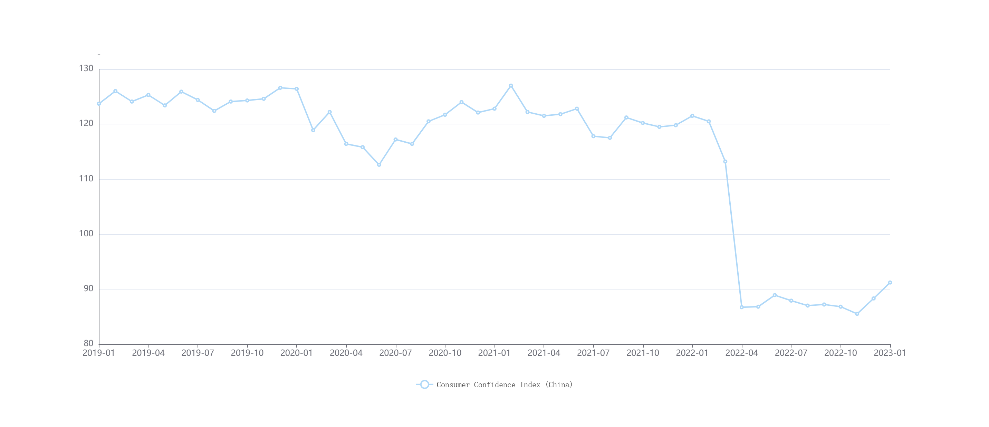
Figure 3: China Consumer Confidence Index (2019.1- 2023.1)[8]
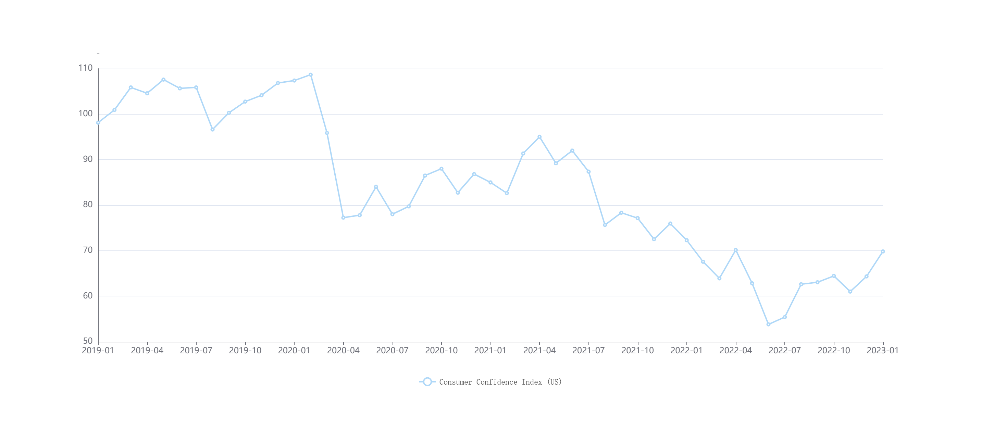
Figure 4: the U.S. Consumer Confidence Index (2019.1- 2023.1)[8]
2.4. Cultural and social factors
Cultural differences can affect the consumption decisions and approaches of consumers in China and the United States. For the United States, individual culturalism dominates. So, consumer behavior in the U.S., especially during the COVID-19, is more inclined to satisfy their own consumption needs, such as home fitness programs or home entertainment products for some video games. In contrast, Chinese culture is more inclined to emphasize on social harmony and collectivism. Therefore, Chinese consumers are more conservative in their consumption behavior and prefer health and safety products.
Furthermore, cultural differences have led to different community structures in China and the U.S., as well as different levels of connectivity within the community. To be more specific, in the U.S., households are more decentralized and consumption is more self-centered. In China, by contrast, people are much more connected and communities often help each other. As a result, during the COVID-19, Chinese consumers often organized purchases of daily necessities and group purchases on a community basis. For example, a common way of purchasing during the COVID-19 in China is for communities to centralize the ordering of ingredients and deliver it to the doorstep of each household.
Cultural and societal factors play an important role in consumer behavior in both the U.S. and China, especially during the epidemic. The different cultural differences and social structures of the two countries have similarly influenced consumption decisions and patterns to some extent, and provide a new perspective for studying changes in consumption behavior in the two countries.
3. Corresponding countermeasures for the micro-economy
Since the outbreak of the COVID-19, the global market has suffered an unprecedented shock, to which the response of micro-entities to such shocks is particularly important, not only affecting the overall macro-economy, but also determining the development prospects of micro-enterprises, even a question of whether or not they can continue to survive. In this context, this paper provides the following recommendations, which are grounded in the research findings.
First of all, enterprises should grasp the opportunity of the times, actively transform to online business, by accelerating the digital transformation, expanding e-commerce platforms, opening social media accounts, please star netroots with goods live and other online consumption pathway to quickly open their own brand of e-commerce market. On this basis, enterprises must ensure the quality of their products and services is not neglected. By giving higher quality products and better level of service to optimize the consumer consumption process, improve consumer satisfaction, and thus enhance consumer confidence in consumption. At the same time, enterprises can also take advantage of the momentum of the transformation of the digital economy, and actively carry out excellent marketing strategies with the help of e-commerce platforms on the amplification of the effect of promotions [9], including but not limited to limited-time discount promotions, to carry out consumer rebates and other activities, as a way to stimulate consumers' desire to spend money. Companies also note that stabilizing their own supply chain enhances the stability of their product supply, enabling them to better navigate future challenges.
4. Conclusion
The COVID-19 pandemic has had a profound impact on consumer behavior in China and the U.S. and globally. In terms of purchasing patterns, the epidemic has accelerated digital transformation, which drives the development of online consumer service platforms and digital payments, while also facilitating the rapid development of live-streaming platforms. In terms of consumer behavior, the epidemic has had a fluctuating or even decreasing effect on consumer confidence indices and has led to an increased focus on health and safety products, as well as an increased preference for local products. Besides, the following are some recommendations for future research. First, studying the long-term effects of the epidemic on consumer behavior such as changes in consumption habits, this paper lacks a temporal analysis of the impact of the epidemic on consumption behavior, whether it changes consumption behavior in the long or short term. Then, an analysis of the impact of government policies on consumer behavior and a comparison of the different effects of different policies on economic recovery in these different countries. What is more, study the impact of the COVID-19 on consumer consumption psychology, including but not limited to the importance of physical health, the importance of social responsibility. Last, to study the changes in consumer spending in different industries after the epidemic, and to examine the challenges faced by different industries, such as the catering and tourism industries, as well as the ways to transform them.
References
[1]. Fidelia, Cascini et al. "A Cross-Country Comparison of Covid-19 Containment Measures and Their Effects on the Epidemic Curves",BMC public health 22.1 (2022): 1765.
[2]. Shaw, Norman et al. "Online shopping continuance after COVID-19: A comparison of Canada, Germany and the United States",Journal of retailing and consumer services 69 (2022): 103100-103100.
[3]. Amankwah-Amoah, Joseph et al. "COVID-19 and Digitalization: the Great Acceleration",Journal of Business Research 136 (2021): 602-611.
[4]. Kimberly L. Jensen* , Jackie Yenerall, Xuqi Chen and T. Edward Yu. (2021). US Consumers’ Online Shopping Behaviors and Intentions During and After the COVID-19 Pandemic. Cambridge core. 53, 416-434.
[5]. Xiong, Y. , Cui, X. , Yu, L. , & Timmermans, H. . (2024). Impact of COVID-19 pandemic on online consumption share: Evidence from China's mobile payment data.
[6]. Claudia D'Arpizio, Federica Levato, Filippo Prete, Constance Gault, and Joëlle de Montgolfier, (January 14, 2021) The Future of Luxury: Bouncing Back from Covid-19, http://https://www.bain.com/insights/the-future-of-luxury-bouncing-back-from-covid-19/, 2024.11.16
[7]. CEIdata. 2019-2023. China macroeconomic statistics for 30 years. https://ceidata.cei.cn/
[8]. CEIdata. 2019-2023. America macroeconomic statistics for 30 years. https://ceidata.cei.cn/
[9]. Tingting Tong et al. “Impact of different platform promotions on online sales and conversion rate: The role of business model and product line length”,Decision Support Systems(2022): 156
Cite this article
Xu,S. (2025). Analysis of the Impact of COVID-19 on Consumption Behavior—Based on the Comparison Between China and the United States. Advances in Economics, Management and Political Sciences,161,7-13.
Data availability
The datasets used and/or analyzed during the current study will be available from the authors upon reasonable request.
Disclaimer/Publisher's Note
The statements, opinions and data contained in all publications are solely those of the individual author(s) and contributor(s) and not of EWA Publishing and/or the editor(s). EWA Publishing and/or the editor(s) disclaim responsibility for any injury to people or property resulting from any ideas, methods, instructions or products referred to in the content.
About volume
Volume title: Proceedings of the 4th International Conference on Business and Policy Studies
© 2024 by the author(s). Licensee EWA Publishing, Oxford, UK. This article is an open access article distributed under the terms and
conditions of the Creative Commons Attribution (CC BY) license. Authors who
publish this series agree to the following terms:
1. Authors retain copyright and grant the series right of first publication with the work simultaneously licensed under a Creative Commons
Attribution License that allows others to share the work with an acknowledgment of the work's authorship and initial publication in this
series.
2. Authors are able to enter into separate, additional contractual arrangements for the non-exclusive distribution of the series's published
version of the work (e.g., post it to an institutional repository or publish it in a book), with an acknowledgment of its initial
publication in this series.
3. Authors are permitted and encouraged to post their work online (e.g., in institutional repositories or on their website) prior to and
during the submission process, as it can lead to productive exchanges, as well as earlier and greater citation of published work (See
Open access policy for details).
References
[1]. Fidelia, Cascini et al. "A Cross-Country Comparison of Covid-19 Containment Measures and Their Effects on the Epidemic Curves",BMC public health 22.1 (2022): 1765.
[2]. Shaw, Norman et al. "Online shopping continuance after COVID-19: A comparison of Canada, Germany and the United States",Journal of retailing and consumer services 69 (2022): 103100-103100.
[3]. Amankwah-Amoah, Joseph et al. "COVID-19 and Digitalization: the Great Acceleration",Journal of Business Research 136 (2021): 602-611.
[4]. Kimberly L. Jensen* , Jackie Yenerall, Xuqi Chen and T. Edward Yu. (2021). US Consumers’ Online Shopping Behaviors and Intentions During and After the COVID-19 Pandemic. Cambridge core. 53, 416-434.
[5]. Xiong, Y. , Cui, X. , Yu, L. , & Timmermans, H. . (2024). Impact of COVID-19 pandemic on online consumption share: Evidence from China's mobile payment data.
[6]. Claudia D'Arpizio, Federica Levato, Filippo Prete, Constance Gault, and Joëlle de Montgolfier, (January 14, 2021) The Future of Luxury: Bouncing Back from Covid-19, http://https://www.bain.com/insights/the-future-of-luxury-bouncing-back-from-covid-19/, 2024.11.16
[7]. CEIdata. 2019-2023. China macroeconomic statistics for 30 years. https://ceidata.cei.cn/
[8]. CEIdata. 2019-2023. America macroeconomic statistics for 30 years. https://ceidata.cei.cn/
[9]. Tingting Tong et al. “Impact of different platform promotions on online sales and conversion rate: The role of business model and product line length”,Decision Support Systems(2022): 156





